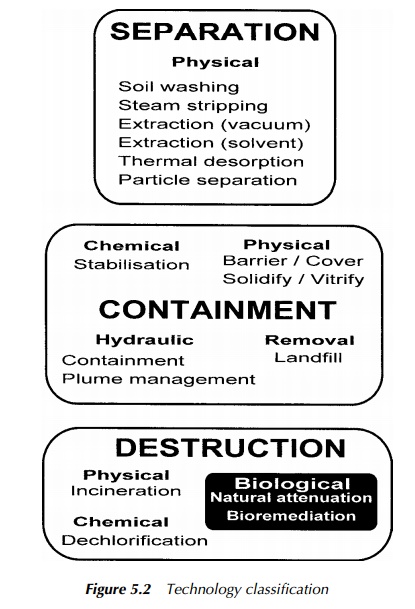Chapter: Environmental Biotechnology: Contaminated Land and Bioremediation
Intensive and Extensive Technologies
Intensive and Extensive
Technologies
Though the in situ/ex situ
classification has established historic precedence, of recent times an
alternative approach to categorise remediation activities has emerged, which
has not yet achieved the same widespread recognition or acceptance, but does,
nevertheless offer certain advantages over the earlier approach. Perhaps the
most significant of these is that it is a more natural division, based on
genuine similarities between technologies in each class. Thus the descriptions
‘intensive’ and ‘extensive’ have been suggested.
Intensive technologies can
be characterised as sophisticated, fast-acting, high intervention strategies,
with a heavy demand for resources and high initiation, running and support
costs. Their key factors are a fast response and low treatment time, which
makes them excellent for heavy contamination conditions, since they can make an
immediate lessening in pollutant impact. Soil washing and thermal treatments
are good examples of ‘intensive’ approaches.
Extensive methods are
lower-level interventions, typically slower acting, based on simpler technology
and less sophisticated engineering, with a smaller resource requirement and
lower initiation, running and support costs. These technolo-gies have a slower
response and a higher treatment time, but their lower costs make wider
application possible, particularly since extensive land remediation treatments
do less damage to soil quality. Accordingly, they are well suited to large-scale
treatment where speed is not of the essence. Examples include composting, the
promotion of biological activity in situ
within the root-zone, precipitation of metal sulphides under anaerobic
conditions and the cropping of heavy metal accumulator plants.
All these systems of
classification are at best generalisations, and each can be useful at different
times, dependent on the purpose of the consideration. They are merely a
convenient way of looking at the available techniques and should not be regarded
as anything more than a helpful guide. As a final aspect of this, it is
possible to examine the various forms of land remediation technologies in terms
of their overall functional principle. Hence, the approaches may be categorised
as ‘destructive’, ‘separating’ or ‘containing’, dependent on their fundamental
mode of operation, as Figure 5.2 illustrates. The principal attraction of this
systemisa-tion is that it is defined on the basis of representing the fate of
the pollutant,

rather than the geographical location of the work or the level of
complexity of the technology used, as in the previous cases. In addition, it
can also be relatively easily extended to take account of any given technology.
Related Topics